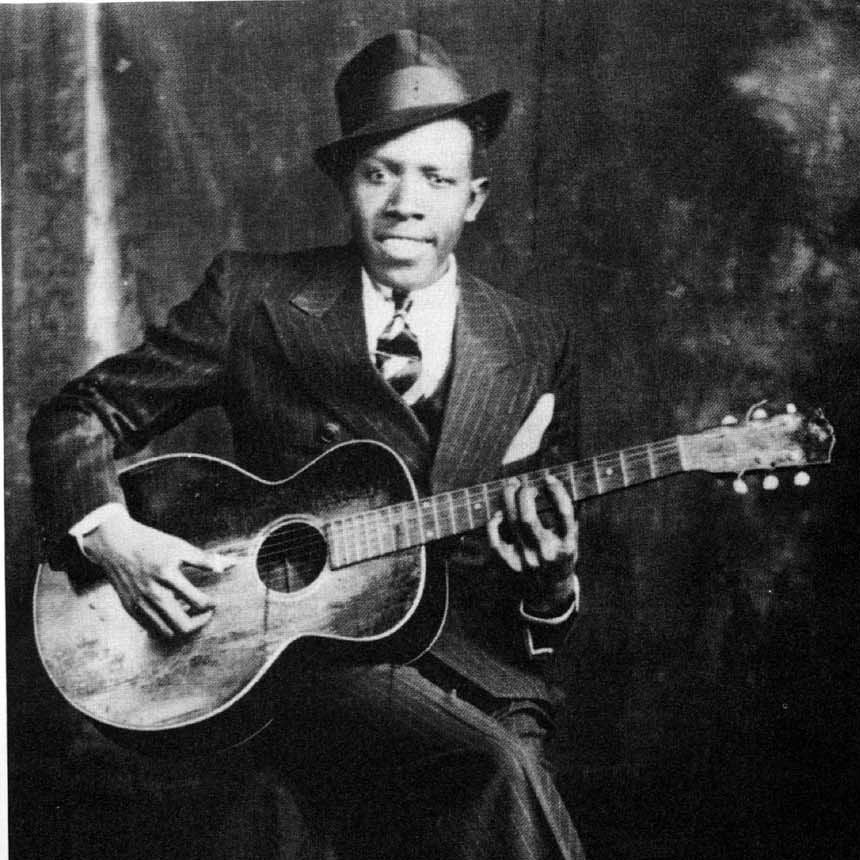
Only take this lesson if you're learning "Dust My Broom."
Also, there's new stuff in the Jam Track Player and Downloads tabs.
Here are your first jam tracks
Jam tracks make practice more fun, and you learn valuable skills you don't learn by playing solo. From now on, every lesson teaching you how to play the song you chose will have jam track players here. At the top, I'll usually give you a couple I recommend for that particular lesson. And below those, you can find all the jam tracks available for that song.Why so many tracks?
It's easier to play along with a track that features a guitar doing the same thing you're doing. And it's also easier to play slow, obviously. So for this lesson, I recommend you start with "Bass Line Quarter Notes (Slow)" track, which means one of the instruments is a guitar playing the same bass line you're playing, with its volume cranked up louder than the other instruments. Once you get good at the slow version of a track, crank up the difficulty and play with the "Full Speed" version. And for the greatest challenge (and greatest rewards), play along with a "Main Jam Track". On those tracks, you'll be the only one playing your part, like in a real band.Recommended Tracks

"Dust My Broom Slow Bass Line Quarter Notes".
- 104:42Bass Line Quarter Notes (Slow)
- 203:05Bass Line Quarter Notes (Full Speed)
All Slow Tracks

- 1Bass Line Quarter Notes
- 2Strummed Whole Notes
- 3Strummed Quarter Notes
- 4Full Strum Pattern
- 5Main Jam Track
All Full-Speed Tracks

"Dust My Broom Bass Line Quarter Notes".
- 103:05Bass Line Quarter Notes
- 203:05Strummed Whole Notes
- 303:05Strummed Quarter Notes
- 403:05Full Strum Pattern
- 503:05Main Jam Track with Vocals
- 603:05Main Jam Track with No Vocals
Here’s the bass line to dust my broom. Learning the bass line will teach you when the chords in the song change, without being distracted by complicated guitar parts. This is what it’s going to sound like. I’ll just play the first verse.
Feel free to print the PDF file of the chord chart linked to on this page, or bring it up on your screen next to this video, or just follow along with the tablature in the video. There are just three notes in this bass line, and they’re all on the 6th string. Let’s find them first. The first note is on the 5th fret, 6th string. This is an “A” note. Play that along with me, make sure it sounds like mine. Next is a “D” note, which is on the 10th fret, 6th string. And finally, the “E” note is the open 6th string.
The song starts with four measures of A. So grab that 5th fret, and play along with me. [play]. Notice that to keep track of the measures, I changed the first number in my beat count. I learned how to do this playing trumpet in my school orchestra when sometimes you had to wait for 30 measures for your part to come in. Next is two measures of D, so move up to the 10th fret, and play along with me. [play]. Now you play two more measures of A, so back to the 5th fret. [play]. Now on the last line of the tablature, things get busy. Play one measure of E (open string) [play], one measure of D [play], one of A [play], and one of E [play].
Notice that this pattern was 12 measures, or bars, long. Dust My Broom is a 12-bar blues tune. The 12 bar blues is a template with which blues musicians have written probably 10s of thousands of songs, and it’s also common ground for musicians who want to jam. So it’s good that you’re learning this pattern early on in your guitar adventures.
Try playing the whole pattern with me once. I’ll call out the count and the changes between notes to help you along.
Now I want you to practice by playing along with the bass line jam track you’ll find on this page, and keep the chord chart in front of you while you do this so that you can get used to following along or at least referring to it if you get lost. Start with the slow jam track, then graduate to the one at full tempo once the slow one’s easy. Full tempo means full speed. You’ll know you’ve practiced enough when you have a good feel for when the notes in the bass line change. Have fun!
How's it going?
Are you loving the lesson? Confused? Have a suggestion? I'd love to hear from you.
